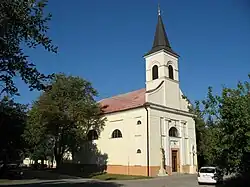Dlhá nad Váhom
Vághosszúfalu | |
|---|---|
village | |
 Church of Holy Trinity | |
 Dlhá nad Váhom Location in Slovakia | |
| Coordinates: 48°10′20″N 17°51′37″E / 48.17222°N 17.86028°E | |
| Country | Slovakia |
| Region | Nitra |
| District | Šaľa |
| First mentioned | 1113 |
| Government | |
| • Mayor | Mgr. Bálint Mészáros |
| Area | |
| • Total | 9.06[1] km2 (3.50[1] sq mi) |
| Elevation | 115[2] m (377[2] ft) |
| Population (2021) | |
| • Total | 913[3] |
| Time zone | UTC+1 (CET) |
| • Summer (DST) | UTC+2 (CEST) |
| Postal code | 927 05[2] |
| Area code | +421 31[2] |
| Car plate | SA |
| Website | http://www.dlhanadvahom.sk/ |
Dlhá nad Váhom (Hungarian: Vághosszúfalu) is a village and municipality in Šaľa District, in the Nitra Region of southwest Slovakia.
Geography
The village lies at an altitude of 118 metres and covers an area of 9.07 km².
History
In historical records the village was first mentioned in 1113. After the Austro-Hungarian army disintegrated in November 1918, Czechoslovak troops occupied the area, later acknowledged internationally by the Treaty of Trianon. Between 1938 and 1945 Dlhá nad Váhom once more became part of Miklós Horthy's Hungary through the First Vienna Award. From 1945 until the Velvet Divorce, it was part of Czechoslovakia. Since then it has been part of Slovakia.
Population
According to the 2011 census, the municipality had 865 inhabitants. 513 of inhabitants were Hungarians, 335 Slovaks, 7 Czechs and 10 others and unspecified.[4]
Facilities
The village has a public library and a football pitch.
Genealogical resources
The records for genealogical research are available at the state archive "Statny Archiv in Bratislava, Nitra, Slovakia"
- Roman Catholic church records (births/marriages/deaths): 1693-1890 (parish A)
See also
References
- 1 2 "Hustota obyvateľstva - obce [om7014rr_ukaz: Rozloha (Štvorcový meter)]". www.statistics.sk (in Slovak). Statistical Office of the Slovak Republic. 2022-03-31. Retrieved 2022-03-31.
- 1 2 3 4 "Základná charakteristika". www.statistics.sk (in Slovak). Statistical Office of the Slovak Republic. 2015-04-17. Retrieved 2022-03-31.
- ↑ "Počet obyvateľov podľa pohlavia - obce (ročne)". www.statistics.sk (in Slovak). Statistical Office of the Slovak Republic. 2022-03-31. Retrieved 2022-03-31.
- ↑ "Archived copy" (PDF). Archived from the original (PDF) on 2012-11-14. Retrieved 2012-08-10.
{{cite web}}: CS1 maint: archived copy as title (link)
External links